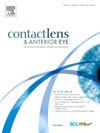Patient considerations versus actual reasons for contact lens cessation: Insights from a survey-based study
IF 3.7
3区 医学
Q1 OPHTHALMOLOGY
引用次数: 0
Abstract
Purpose
To analyze and compare non-contact lens-related and contact lens-related reasons influencing cessation considerations in current contact lens wearers (CLWs) with the actual reasons for cessation reported by discontinued CLWs.
Methods
This was an cross-sectional study with face-to-face survey administered to current and discontinued CLWs by trained optometrists at the General Óptica centers across Spain. The survey included basic demographic information, and explored both non-contact lens-related and contact lens-related reasons that led current CLWs to consider cessation or resulted in cessation among discontinued CLWs.
Results
A total of 1266 surveys, including 764 from current CLWs and 502 from discontinued CLWs, were included. Regarding non-contact lens-related reasons for cessation, discontinued CLWs more frequently reported a “Preference for wearing spectacles” (13.1 % vs. 3.8 %, P < 0.05) and “Recommendation by an eye care practitioner” (5.2 % vs. 0.6 %, P < 0.05), while current CLWs more often cited “Refractive surgery” (15.8 % vs. 9.4 %, P < 0.05). For contact lens-related reasons for cessation, discontinued CLWs more frequently reported “Difficulty handling contact lenses” (10.6 % vs. 1.9 %, P = 0.001), whereas current CLWs more commonly cited “Contact lens-related ocular symptoms” (57.6 % vs. 43.8 %, P < 0.05). Agreement between groups was generally low for all reasons analyzed, ranging from −0.115 to 0.103.
Conclusions
The reasons for cessation from the perspective of current and discontinued CLWs yield different results. By addressing the reasons considered by current CLWs, while taking into account the reasons most strongly associated with cessation in discontinued CLWs, eye care practitioners could proactively prevent CL cessation.
患者考虑与停用隐形眼镜的实际原因:来自一项基于调查的研究的见解。
目的:分析和比较影响当前隐形眼镜佩戴者(clw)戒烟考虑的非隐形眼镜相关和隐形眼镜相关原因与已停用隐形眼镜佩戴者报告的实际戒烟原因。方法:这是一项横断面研究,面对面调查由西班牙Óptica中心训练有素的验光师进行。该调查包括基本的人口统计信息,并探讨了导致当前clw考虑戒烟或在已停用clw中导致戒烟的非隐形眼镜相关和与隐形眼镜相关的原因。结果:共纳入1266份调查,其中764份来自目前的clw, 502份来自已终止的clw。对于非隐形眼镜相关的戒烟原因,停药的clw更频繁地报告“更喜欢戴眼镜”(13.1%对3.8%)。结论:从当前和停药的clw的角度来看,戒烟的原因产生了不同的结果。通过解决当前clw所考虑的原因,同时考虑到与终止clw最密切相关的原因,眼科保健医生可以主动预防clw停止。
本文章由计算机程序翻译,如有差异,请以英文原文为准。
求助全文
约1分钟内获得全文
求助全文
来源期刊

Contact Lens & Anterior Eye
OPHTHALMOLOGY-
CiteScore
7.60
自引率
18.80%
发文量
198
审稿时长
55 days
期刊介绍:
Contact Lens & Anterior Eye is a research-based journal covering all aspects of contact lens theory and practice, including original articles on invention and innovations, as well as the regular features of: Case Reports; Literary Reviews; Editorials; Instrumentation and Techniques and Dates of Professional Meetings.
 求助内容:
求助内容: 应助结果提醒方式:
应助结果提醒方式:


